Legacy systems still drive billion-dollar aerospace projects - and that’s a problem. From delayed launches to missed defect signals, the cost of outdated tools is rising fast. In an industry where failure isn’t an option, the question isn’t if change is needed - it’s when.
That’s exactly where the question of how AI can assist aerospace project teams becomes impossible to ignore.
In this article, we will:
- See how AI is powering real results for aerospace teams
- Explore how top aerospace companies are winning with AI
- Tackle the real-world challenges of AI in aerospace projects
AI's Transformative Impact on Aerospace Teams: 6 Critical Applications Driving Success
The aerospace industry faces unprecedented complexity in project management, from coordinating global supply chains to meeting stringent safety regulations. Artificial intelligence is revolutionizing how aerospace project teams tackle these challenges, delivering measurable improvements in efficiency, cost reduction, and risk mitigation.
Here are six transformative ways AI is reshaping aerospace project success.
1. Predicting Component Failures Before Critical Breakdowns Occur
Unscheduled maintenance is the nemesis of aerospace project timelines, often causing delays that ripple through entire programs. AI-powered predictive maintenance transforms this reactive approach into a proactive strategy that keeps projects on track.
- Real-time sensor monitoring processes thousands of data points per second from aircraft components
- Pattern recognition algorithms identify subtle changes indicating potential failures weeks in advance
- Automated alert systems notify maintenance teams before issues become critical
- Maintenance scheduling optimization coordinates repairs during planned downtime
- Historical data analysis continuously improves prediction accuracy across fleet operations
This predictive approach reduces unscheduled maintenance by up to 35% and allows project teams to plan with confidence, knowing their aircraft assets will be available when needed.
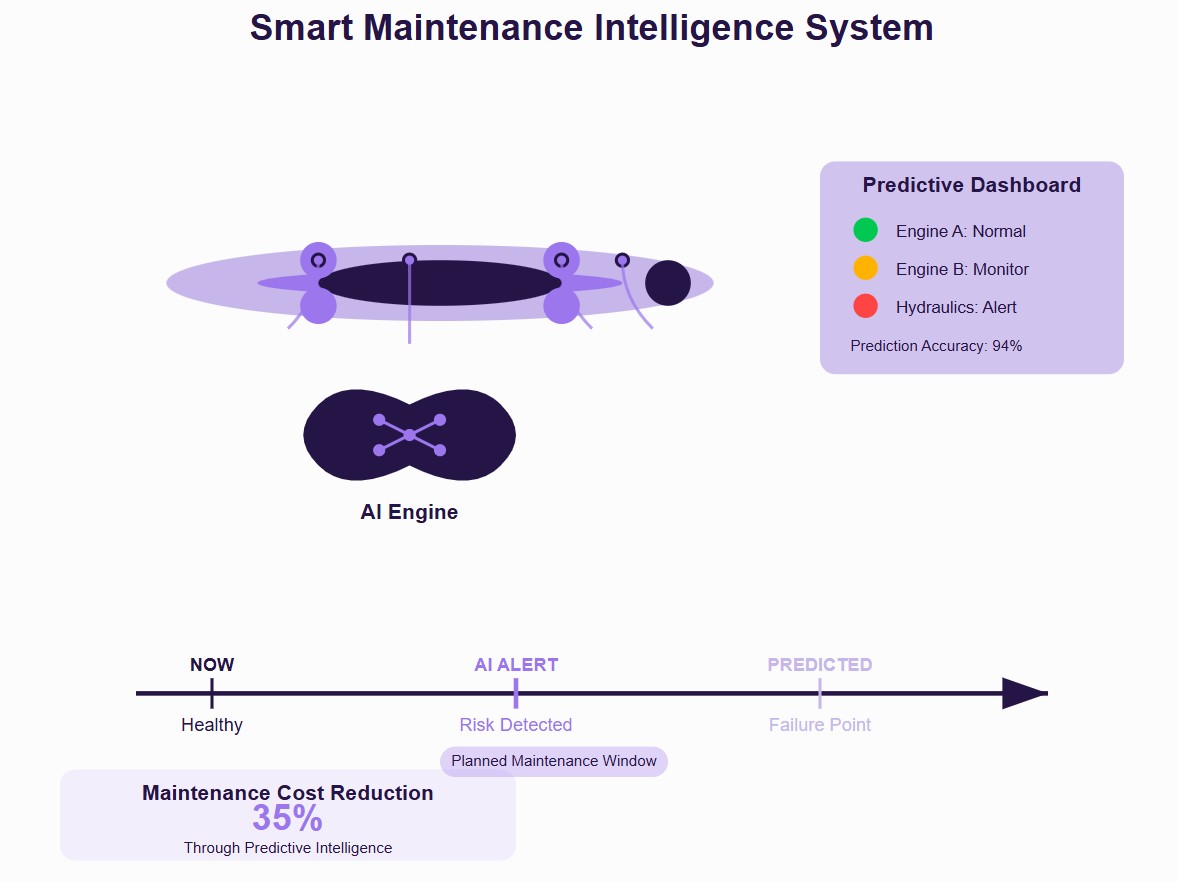
2. Creating Virtual Prototypes That Eliminate Costly Physical Testing
Physical prototyping in aerospace requires enormous investments in time and resources. Digital twin technology, powered by AI, creates virtual replicas that behave like real aircraft, revolutionizing how teams validate designs.
- Physics-based simulations replicate complex aerodynamic and structural behaviors
- Real-time performance modeling tests thousands of design variations simultaneously
- Virtual wind tunnel testing eliminates expensive physical testing for initial design phases
- Automated design optimization suggests improvements based on simulation results
- Rapid iteration cycles accelerate development timelines by 40-60%
Teams using AI-powered virtual prototyping slash development costs while achieving better-performing designs through extensive virtual testing impossible with physical prototypes.
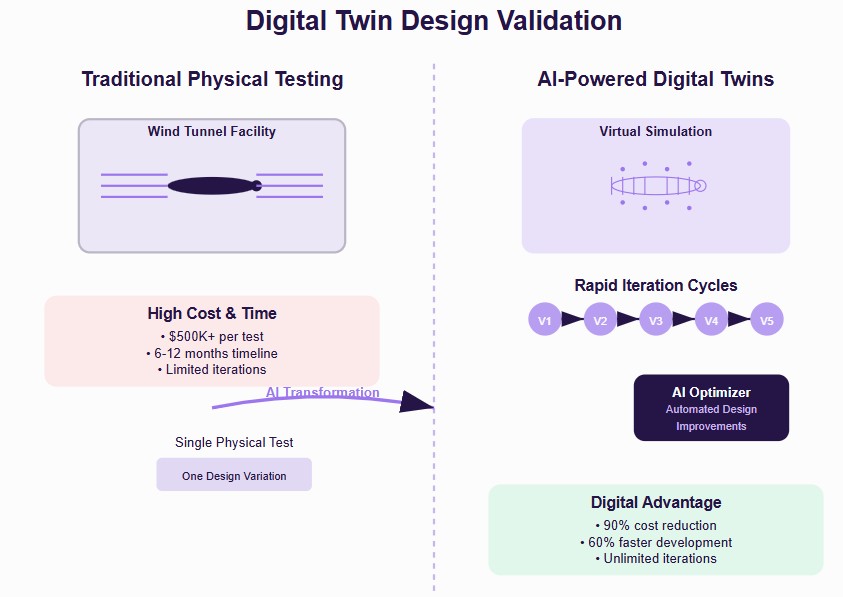
3. Orchestrating Complex Supply Chains With Predictive Intelligence
Aerospace supply chains involve thousands of suppliers across global networks, making coordination a monumental challenge. AI brings intelligence to this complexity, transforming supply chain management from reactive to predictive.
- Demand forecasting algorithms predict material requirements 6-12 months in advance
- Supplier risk assessment monitors financial health and delivery performance continuously
- Dynamic inventory optimization balances availability with carrying costs
- Alternative sourcing recommendations activate automatically when risks are detected
- Delivery schedule optimization coordinates arrivals with production needs
Supply chain disruptions decrease by 45% when AI systems manage procurement intelligence, keeping projects flowing smoothly despite global uncertainties.
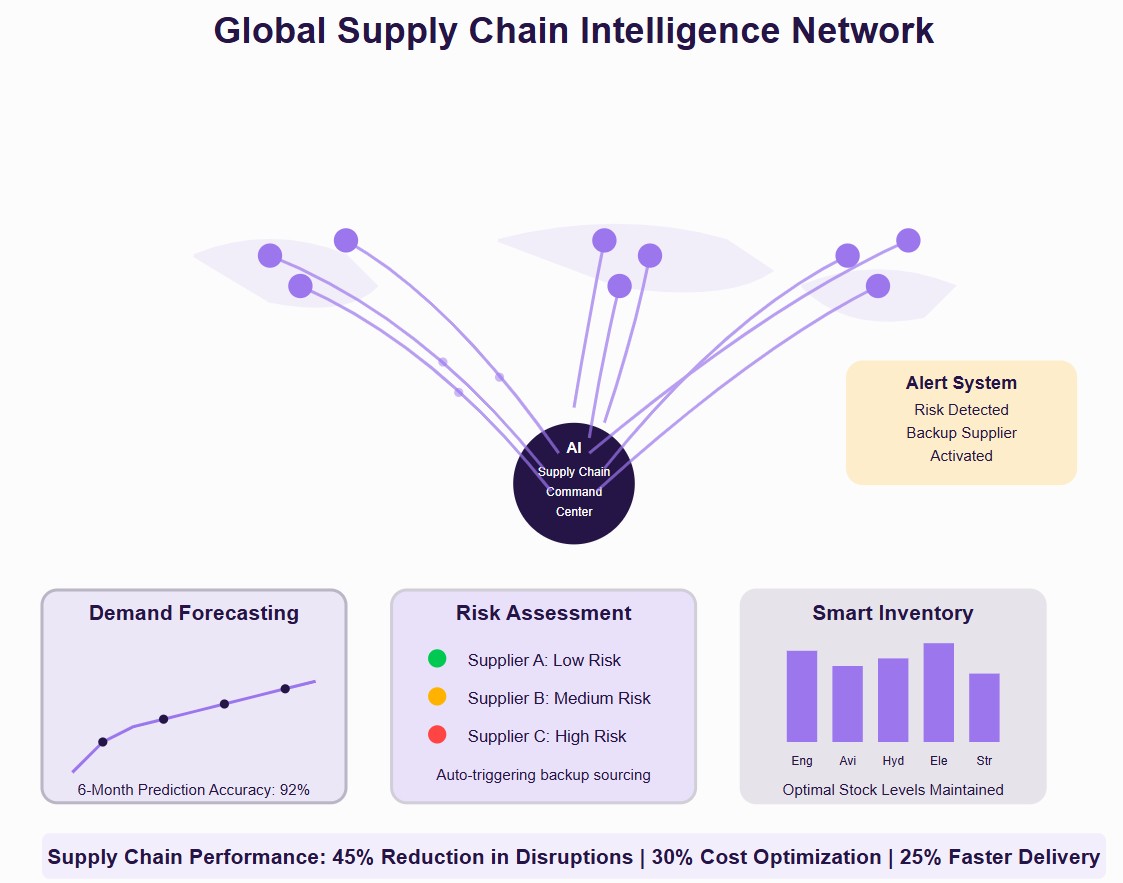
4. Accelerating Compliance Documentation and Regulatory Processes
Regulatory compliance consumes enormous resources in aerospace projects, often requiring months of manual documentation preparation. AI automates these processes, ensuring compliance while freeing teams for higher-value activities.
- Automated report generation compiles safety certification documents from project data
- Traceability documentation maintains component history from design through installation
- Regulatory change monitoring tracks updates and assesses project impacts automatically
- Compliance gap analysis identifies missing documentation before audits
- Standard formatting ensures all reports meet specific regulatory requirements
AI-driven compliance processes reduce documentation time by 60% while improving accuracy and reducing the risk of regulatory delays.
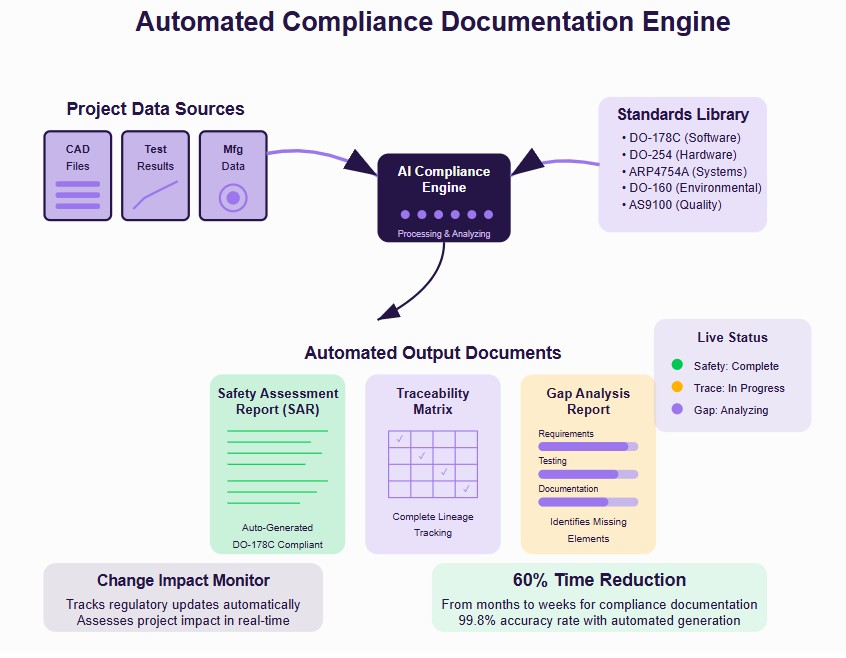
5. Optimizing Cross-Functional Team Coordination and Communication
Modern aerospace projects require seamless coordination across multiple disciplines, time zones, and organizations. AI-powered collaboration tools transform how distributed teams work together effectively.
- Intelligent scheduling coordinates complex calendars across global teams and time zones
- Automated meeting transcription captures decisions and extracts action items
- Real-time language translation enables effective communication across international teams
- Context-aware notifications deliver relevant information without overwhelming team members
- Knowledge management systems instantly locate expertise and historical project data
Teams using AI collaboration tools report 30% faster decision-making and improved coordination, which can be captured effectively in a project closure report at the end of each phase.
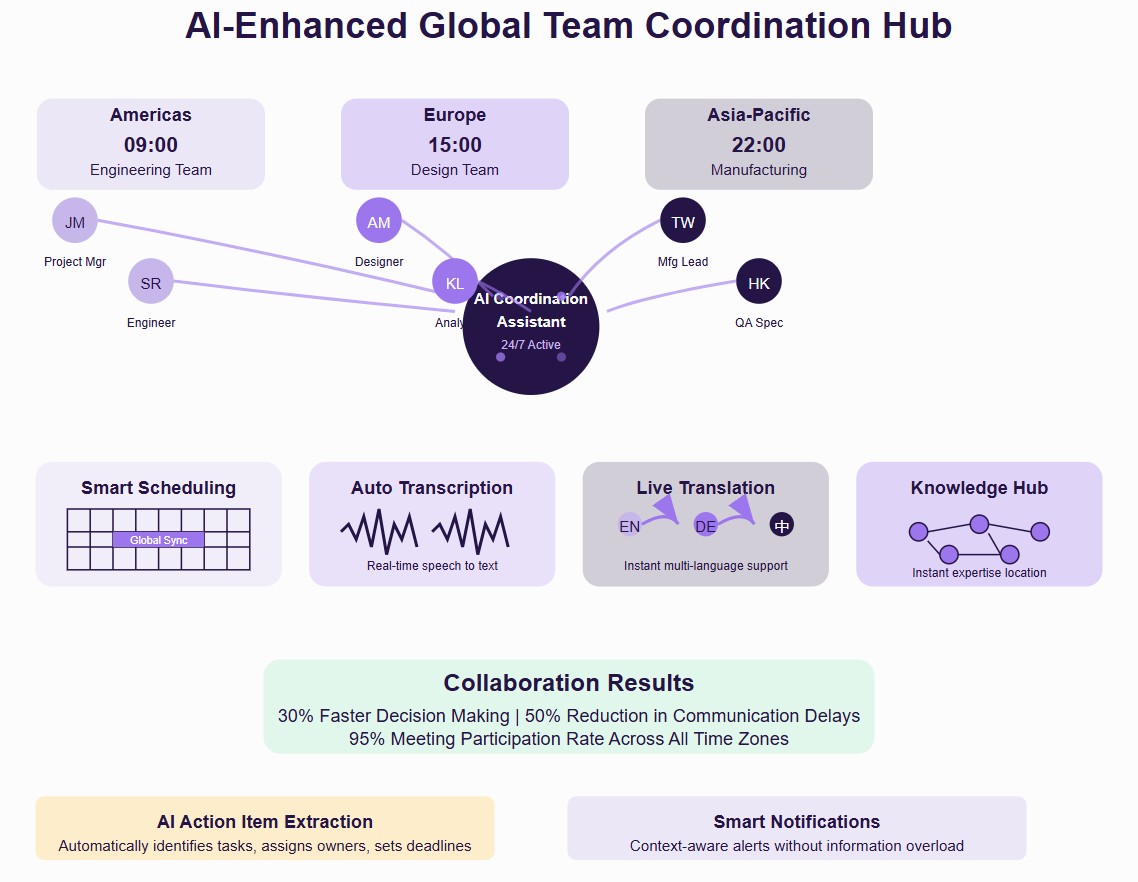
6. Enabling Intelligent Risk Management and Decision Support
Aerospace projects face countless variables that can impact success, from technical challenges to market fluctuations. AI provides unprecedented visibility into risks and supports data-driven decision-making, especially when paired with tools like a project impact assessment template to evaluate potential disruptions.
- Predictive risk analytics identify potential problems months before they materialize
- Scenario modeling simulates thousands of "what-if" situations for contingency planning
- Automated performance monitoring tracks progress and flags deviations in real-time
- Decision support algorithms recommend optimal responses to changing conditions
- Historical pattern analysis learns from past projects to improve future risk assessment
Project teams using AI risk management report 50% fewer critical issues reaching crisis level, enabling smoother project execution and better outcomes.
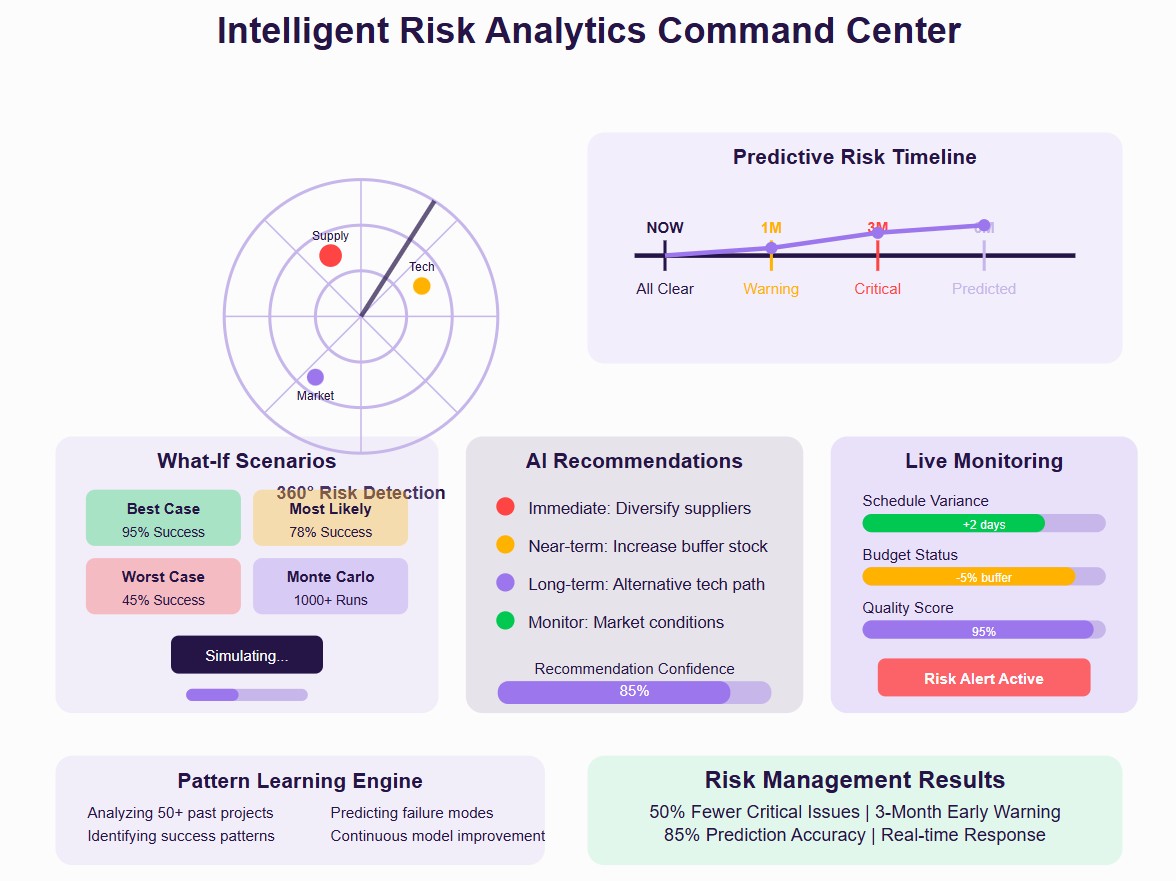
Teams that implement these technologies gain significant advantages in cost management, timeline adherence, and quality outcomes.
Proven Success: How Industry Giants Are Revolutionizing Aerospace with AI
Let’s explore three verified case studies that prove how AI is not just assisting, but transforming aerospace project execution.
NASA: Leading the Way in Autonomous Mission Control
NASA has deployed over 50 AI use cases across planetary exploration, mission planning, and spacecraft operations (2024 AI Use Case Inventory).
Flagship Success: The Perseverance Rover on Mars
- Powered by the Enhanced AutoNav system, the rover uses:
- AEGIS to autonomously collect scientific data
- MLNav for terrain navigation without Earth-based instructions
- PIXL Adaptive Sampling to intelligently target mineral-rich rocks
- An onboard planner to schedule daily operations autonomously
Impactful Results:
- Over 150,000 telemetry data points processed per spacecraft test
- Target selection and task planning reduced from days to real-time
- Autonomous sampling extended scientific operations during Earth communication blackouts
NASA has also leveraged AI in design innovation. For the EXCITE Mission, AI-generated spacecraft components are offered:
- Radical structural designs - stronger, lighter, and quicker to manufacture
- Thousands of custom parts are developed annually via AI design tools
Airbus: Predictive Maintenance with Skywise
Airbus's Skywise platform, launched with Palantir, is the world's largest aviation data ecosystem - used by 140+ airlines and thousands of aircraft.
What Skywise Does:
- Predicts equipment failures using real-time flight data
- Monitors aircraft nose-to-tail via Fomax routers and 4G Gatelink antennas
- Detects faults via NLP-based diagnostic tools
- Uses collaborative data from Delta, Emirates, easyJet, Qantas, and more
Real Results:
- 35 flight cancellations avoided by one airline in a single month (Aug 2022)
- 10–20% time savings in maintenance decision-making
- 1% improvement in fleet reliability for Emirates A320/A330
- Maintenance savings of 10% from just 0.3% reliability uplift
Lockheed Martin: Scaling Intelligence with the AI Factory
Lockheed Martin industrialized AI through its AI Factory, built on NVIDIA DGX SuperPODs, powering over 8,000 engineers across its operations.
Core Capabilities:
- Development of digital twins, simulations, and MLOps pipelines via the ARISE toolkit
- AI-assisted enterprise tools like LMText Navigator
- Full compliance with DoD’s AI ethical guidelines
Deployment Outcomes:
- Thousands of automated pipelines are trained weekly
- Support for projects like:
- DARPA’s AIR Program: Simulates multi-ship aircraft behavior for BVR missions
- Aegis Combat System AI: Improves threat recognition in real-time
- VISTA X-62A Aircraft: Trains AI copilots and simulates air combat autonomously
Overcoming AI Roadblocks: Key Challenges Aerospace Teams Must Navigate
While the benefits of AI in aerospace project management are transformative, the path to implementation isn’t without turbulence. From legacy systems to regulatory complexity, several critical hurdles can slow or derail progress.
Below are the most common challenges aerospace teams face, along with mitigation strategies and lessons learned.
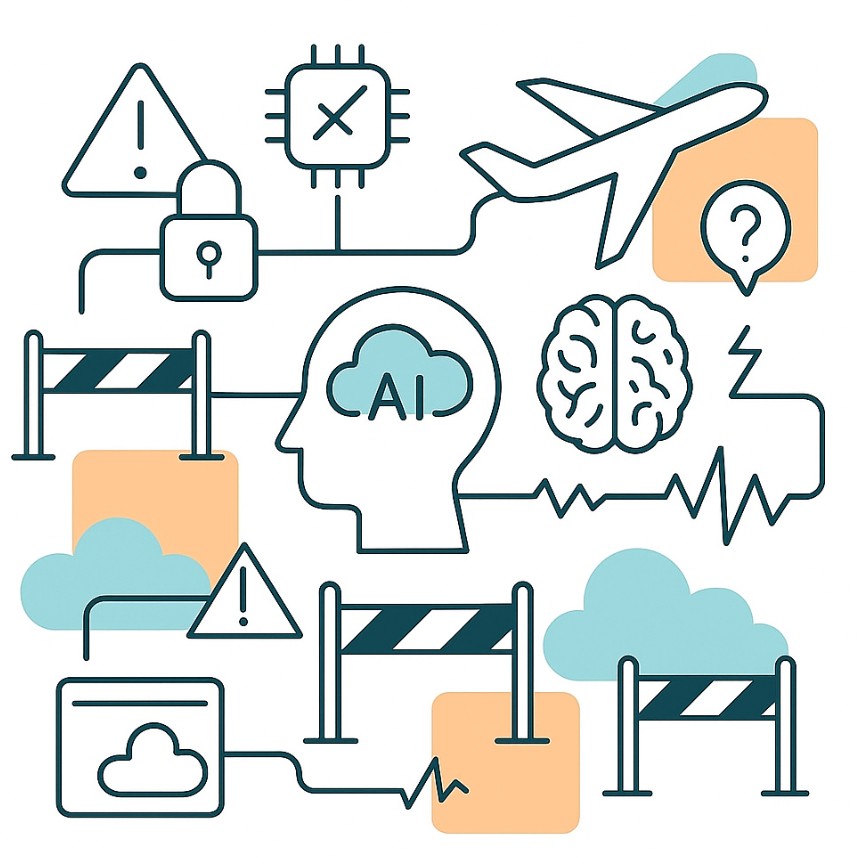
Technical Integration with Legacy Aerospace Systems
Many aerospace companies rely on decades-old software and hardware infrastructure built for stability, not agility. Integrating AI into these environments poses serious compatibility issues.
- Legacy systems often lack APIs or real-time data access, making it difficult to ingest and analyze operational inputs
- AI models may require cloud-native environments, while aerospace infrastructure is often on-premise and air-gapped for security
Solution: Use middleware platforms or digital twins as integration bridges. Gradual AI adoption - starting with non-intrusive modules like predictive dashboards - can help validate use cases without overhauling core systems.
Regulatory Approval in Safety-Critical Environments
Deploying AI in flight operations, testing, or mission-critical planning must meet the highest safety standards, often governed by agencies like the FAA, EASA, or DoD.
- AI models must be explainable, especially in decisions affecting airworthiness or flight readiness
- Regulatory bodies may resist black-box algorithms without proper traceability or testing protocols
Solution: Prioritize interpretable AI and document how models align with existing validation frameworks (e.g., DO-178C for software compliance). Engage regulators early in the development process to avoid roadblocks later.
Data Quality and Cybersecurity Risks
AI is only as good as the data feeding it, but aerospace teams often struggle with:
- Fragmented datasets across engineering, supply chain, and manufacturing
- Sensitive data governed by strict defense-grade security protocols
- Risk of cyberattacks targeting mission-critical AI systems
Solution: Establish centralized data lakes with role-based access, apply rigorous data hygiene protocols, and adopt AI-specific cybersecurity frameworks (e.g., adversarial defense in ML models).
Workforce Resistance and the AI Skill Gap
AI adoption can trigger fears of job displacement or skepticism from experienced aerospace engineers.
- Some teams may resist automation, viewing it as a threat to craftsmanship and safety
- Others may lack the skills to work with AI tools, leading to poor adoption
Solution: Position AI as an augmentation tool, not a replacement. Invest in cross-skilling programs that combine aerospace domain knowledge with data literacy. Highlight success stories where engineer-AI collaboration led to measurable wins.
Vendor Selection Pitfalls
Choosing the wrong AI vendor—or one that lacks aerospace expertise—can lead to wasted time and resources.
- Some vendors overpromise AI capabilities without understanding aerospace constraints
- Lack of support for on-premise, classified, or high-integrity environments can be disqualifying
Solution: Evaluate vendors based on:
- Domain experience in regulated industries
- Support for MIL‑STD, AS9100, or other aerospace standards
- Proof of long-term scalability and explainability features
Consider pilot programs to test vendor solutions in real-world conditions before full rollout.
The teams that acknowledge these hurdles upfront and develop comprehensive mitigation strategies are the ones that ultimately achieve transformative AI benefits.
Transform Deadweight Systems Into Data-Driven Success
Legacy systems can’t keep up with the speed, scale, and complexity modern aerospace demands. From predictive maintenance to autonomous mission control, AI is solving the problems that once stalled progress.
The companies leading the next era of aerospace aren’t just adopting AI - they’re building with it at the core. If your team is still battling outdated tools, now’s the time to shift. Let AI turn delays into decisions, bottlenecks into breakthroughs, and projects into progress.


.png)
_light%201.png)





